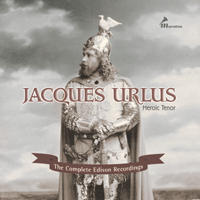A Note from Ward Marston
Jacques Urlus was already a veteran of the recording studio by the summer of 1913 when he cut his first disc recordings for the Edison Company. In fact, he had previously made over seventy-five sides for Pathé and the Gramaphone Company between 1903 and 1912. Although many of these discs are eagerly sought by collectors, his Edison discs, presented here in their entirety, are unquestionably his greatest. This is due in no small measure to the fact that Urlus’s voice was so magnificently captured by Edison’s recording method.
Thomas Edison began experimenting with disc recording early in the year 1910, and even at the age of sixty-five, he approached the project with tremendous enthusiasm and vigor. He took a personal interest in all aspects of disc recording, manufacture, and reproduction. He also decided to take an active part in the auditioning of musicians to be recorded. This was unfortunate since Edison possessed at best a rudimentary knowledge of music and no talent for making such decisions. He was, by this point, almost completely deaf and one can only speculate as to what opera singing must have sounded like to his ears. Nevertheless, his opinionated and often negative comments on well-known singers have often been quoted and could well be the subject of a most amusing essay.
Jacques Urlus recorded ten sides during his first session for Edison in his London studio in July 1913. Once the wax masters had been received in New York for processing, six titles were chosen for publication and assigned catalogue numbers. They were immediately withdrawn, however, probably because they had been incorrectly recorded at 75 rpm instead of the 80 rpm speed upon which Edison insisted. Only two of these titles have ever surfaced as commercial pressings. A third disc from this group exists in test pressing form at the Edison National Site. (CD1, Tracks 1-3)
The following February saw Urlus in London again, re-recording most of the previously rejected titles. This session only yielded one satisfactory item—“Mein lieber Schwan” from Lohengrin which replaced the 1913 recording. This version, (CD 1, Track 4) was also quickly withdrawn for reasons unknown. With the outbreak of World War I, Edison shut down all recording operations in Europe and thereafter, recording was confined to his New York studio. During Urlus’s first New York session, he once again recorded many of the same titles and this time, all were published. For the next two years, Jacques Urlus recorded some forty titles for Edison, many of which remained in the catalogue until the company went out of business in 1929. Thomas Edison was particularly delighted with Urlus, whose name he quite consistently misspelled Urlis. I quote here two of Edison’s handwritten evaluations.
L’Africaine “O paradis”: “Splendid—no tremolo. Caruso cannot possibly best this. Urlis in fine voice—talk to him about it.”
Siegfried “Schmiedelied”: “The whole record is good. The music is especially good - dramatic. If we could get the same dramatic effect on other opera pieces, it would be good.”
Jacques Urlus wrote to Edison on 5 April 1915 thanking him for sending samples of some of his newly recorded records along with a machine. Over top of Urlus’s letter, Edison penned the following comments intended for his reply.
“We all notice that when the tunes you sing are composed of long sustained notes and are not broken up by a number of german (sic) words, they are very beautiful. Too much talking in german (sic) is fatal to the musical quality – the chords cannot talk and sing simultaneously without bad results. I hope the next time you will let us have some songs like the Eve Star from Tannhauser which are suitable for tenor.”
Aside from musical matters, Edison insisted upon the highest standards of technical excellence in record production. In 1923, for example, one Edison dealer wrote that a customer had complained that Urlus’s record of “Siegmund heiss ich” blasted on loud notes. Edison immediately had the record evaluated by several assistants. It was indeed found defective and quickly placed on the cut out list.
I have presented here all of Urlus’s Edison recordings in chronological matrix number order except for the two arias from Die Meistersinger which I have placed together for the sake of musical continuity. In cases where two takes were available, I invariably opted for the one with superior sound since Urlus was interpretively consistent from take to take. Transferring these discs presented few obstacles and as I worked, I was completely free to revel in Urlus’s artistry. It is my hope that this issue will help to establish him solidly in the pantheon of great “Helden tenors”.

Jacques Urlus, Heroic Tenor
The Complete Edison Recordings
Jacques Urlus made almost 150 recordings, beginning with 25 cylinders sung in Dutch for Pathé in 1903, and ending with two electrics for Odeon in 1927. These CDs are devoted to the Edisons, which reproduce Urlus’s voice during his triumphant Metropolitan seasons, from 1913-1917. His Edison discs, presented here in their entirety, are unquestionably his greatest. This is due in no small measure to the fact that Urlus’s voice was so magnificently captured by Edison’s recording method.